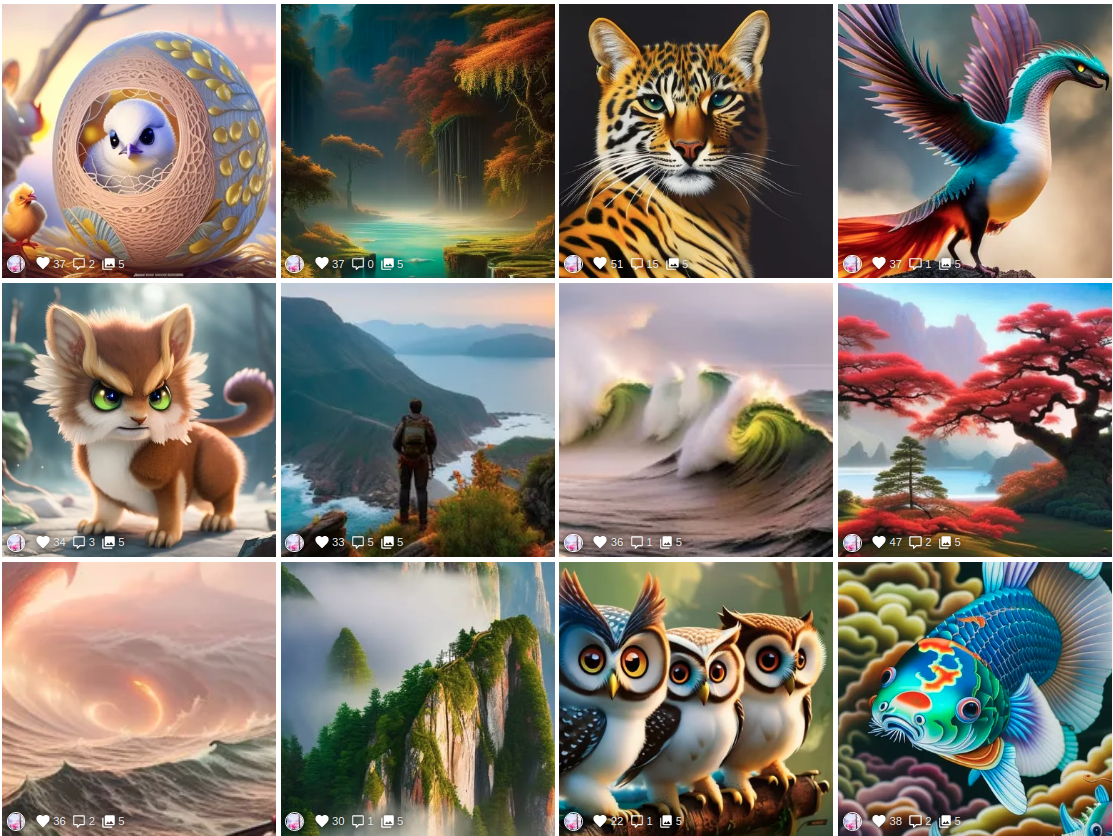NightCafe Studio is known for its eclectic approach to generate images from text, utilizing a variety of different movements and styles in its prompts. Some popular movements and styles used by the studio include impressionism, which is characterized by the use of light and color to create a fleeting, atmospheric effect; cubism, which is marked by the geometric simplification of forms and the emphasis on abstraction; and surrealism, which is characterized by the use of dream-like imagery and the exploration of the subconscious. Additionally, the studio is known for incorporating elements of pop art, which is marked by the use of bold, bright colors and the depiction of popular culture icons, as well as elements of abstract expressionism, which is marked by the use of spontaneous, gestural brushstrokes and the emphasis on the process of creating the art. Overall, NightCafe Studio’s approach to AI Art is marked by a willingness to experiment with different movements and styles, while always maintaining a strong focus on creating visually striking, thought-provoking pieces.This post explains the frequently used terms about art movements and styles.
Table of Contents
What is academic art?
Academic art is a term used to describe the style of art that was taught and promoted in art schools and academies during the 19th century. It was characterized by a focus on technical skill, realistic representation, and the study of classical art and the human form. This style of art was considered to be the standard for high-quality art and was often used as a contrast to other styles such as Impressionism, which were considered to be more experimental and avant-garde.
Academic art was heavily influenced by the ideals of the Renaissance and the classical art of ancient Greece and Rome. Artists were trained to depict the human form in a realistic and accurate manner, and to pay attention to details such as anatomy, proportions, and perspective. This emphasis on technical skill and traditional subject matter was considered to be essential for an artist to be considered truly “skilled” or “talented”.
Academic art was also associated with the official government-supported art institutions such as the French Academy of Fine Arts and the Royal Academy of Arts in London, which were seen as the main institutions in determining the standard for high-quality art and training.
Academic art was dominant for many years in the art world but eventually declined in popularity around the late 19th century as new art movements such as Impressionism and Symbolism began to emerge and gain recognition. Today, academic art is considered as a historical art movement and it serves as a foundation to many modern art styles, as many of the academic principles such as human anatomy and perspective are still used and highly valued in the art world.
What is action painting?
Action painting is an art style that emerged in the 1940s and 1950s as part of the abstract expressionist movement. It is characterized by a focus on spontaneous, gestural brushstrokes, and the physical act of painting itself. Artists associated with the movement often used large canvases and worked on them using an intuitive and immediate approach, rather than a preconceived plan. The finished painting often appears as an evidence of the process of painting itself, rather than a depiction of a specific subject or object.
The style is also known as “gestural abstraction” and it is associated with the work of artists such as Jackson Pollock, Willem de Kooning, and Mark Rothko. These artists worked on a large scale, often using unconventional tools such as dripping and pouring paint, allowing the physical act of painting to take center stage.
The term “action painting” was coined by the art critic Harold Rosenberg in 1952, and it was meant to convey the sense of movement, energy and the physicality of the brushwork. This new art form was revolutionary because it broke away from traditional notions of painting as representation, instead it focused on the process and the emotional content of the work.
Action painting was an essential part of the American abstract expressionism, and it had a significant impact on the art world and the development of other movements such as color field painting and minimalism. Even today, the legacy of action painting is still felt in contemporary art, and many artists continue to use similar techniques and methods in their work.
What is art Brut?
Art Brut, also known as “outsider art,” is a term used to describe art that is created by individuals who are outside the mainstream art world and have little or no formal training in art. The term was coined by the French painter Jean Dubuffet in the 1940s to describe art that is created by people who are “unspoiled by artistic culture.” The artworks produced by these individuals are considered to be raw, authentic, and personal expressions of the artist’s inner experience and are seen as representing a unique vision that is uninfluenced by the conventions of the art world.
Art Brut is often created by people who have been diagnosed with mental illness, are in institutions, or are considered to be outsiders to society such as prisoners or self-taught artists. The artworks produced can be quite diverse, but they often display a strong emotional content, and they can be in various mediums, such as drawing, painting, sculpture, collage, or assemblage.
Some famous examples of Art Brut include the works of the French painter Henri “Le Douanier” Rousseau, the Swiss painter Adolf Wölfli, or the American artist James Castle.
Art Brut is considered to be a form of folk art, it is a way to understand the human condition as it is, free from the constraints of culture, education, and social conventions. It is an important movement in the art world, as it represents a different perspective and a non-traditional approach to art making. It also serves as a reminder that anyone can be an artist and that artistic talent is not limited to those who have had formal training.
What is art deco?
Art Deco is a style of visual arts, architecture, and design that emerged in the 1920s and 1930s and was popular until the 1940s. The style is characterized by its geometric shapes, bold colors, and the use of new materials and technologies. The name “Art Deco” comes from the Exposition Internationale des Arts Décoratifs et Industriels Modernes, a world’s fair held in Paris in 1925, where the style was first showcased.
Art Deco is heavily influenced by the modernist art movements of the early 20th century, such as cubism and futurism, but it also incorporates elements of traditional decorative arts, such as motifs from ancient Egypt, Greece, and Rome, as well as from indigenous cultures from Africa, Oceania, and the Americas.
The style is characterized by its use of geometric shapes, such as circles, triangles, and rectangles, as well as bold, symmetrical designs. It also makes use of new materials such as plastic, aluminum, and stainless steel and often uses techniques such as inlay, marquetry, and lacquer. In architecture, Art Deco buildings are often characterized by their sleek lines, streamlined forms, and the use of new materials such as terra-cotta, stainless steel and aluminum.
Art Deco was popular in many different fields, from architecture, interior design, fashion, jewelry, graphic design, and even in film and advertising. Some of the most famous examples of Art Deco architecture are the Empire State Building, the Daily Express Building in Manchester and the Chapman Building in Los Angeles.
Art Deco style is considered to be a reflection of the optimism and the desire for a new and modern way of life that emerged after the end of World War I. Today, the Art Deco style remains an enduring and popular design aesthetic
and can be found in many different forms, from vintage furniture and fashion to contemporary graphic design and architecture.
What is art Nouveau?
Art Nouveau is an art and design style that emerged in the late 19th century and was popular until the first World War. The style is characterized by its use of flowing, organic lines, and a focus on natural forms, such as plants and flowers. The name “Art Nouveau” means “new art” in French, and it was intended to be a break from the traditional and academic art of the time.
Art Nouveau is characterized by its use of asymmetrical designs, curved lines, and the combination of different materials such as glass, metal, and ceramics. In architecture, it is known for its use of ornamental details, such as curved forms, organic motifs, and highly decorated facades.
The style is heavily influenced by the work of the Belgian architect and designer Henry van de Velde and it spread quickly throughout Europe and later to the United States and other countries. In architecture, some of the most famous examples of Art Nouveau can be found in the work of Antoni Gaudi in Barcelona and Victor Horta in Brussels.
Art Nouveau was also influential in other forms of design, such as graphic design, furniture, and jewelry. The style was also popular in the decorative arts, such as glassware, ceramics, and textiles, and the work of the famous glass designer Louis Comfort Tiffany is a good example of this.
Art Nouveau is considered a transitional style between the academic art of the 19th century and the more radical styles of the early 20th century. It sought to break away from traditional forms, instead it celebrated the new technologies of the time, and it was an attempt to create a new style that was unique and modern.
What is ashcan school?
The Ashcan School is a group of American realist artists who emerged in the early 20th century, also known as the Ash Can School, The Eight or The group of Eight. They were known for their gritty and realistic depictions of everyday urban life, particularly in New York City, and for their rejection of traditional academic art in favor of a more modern and honest approach to art.
The group was led by the artist Robert Henri, who was a strong advocate for the importance of painting from life and for the representation of the new urban reality that was emerging in America at the turn of the century. The artists associated with the Ashcan School were known for their use of bold brushstrokes, dark tones and a keen attention to detail. They also showed a deep interest in capturing the mood of the city, the energy of the streets, and the real people who lived there.
Some of the most famous artists associated with the Ashcan School include Robert Henri, George Luks, William Glackens, and John Sloan. The Ashcan School’s work had a significant impact on the development of American art and on the art world in general, as it represented a new approach to art that was focused on contemporary life, and it depicted the reality of the modern urban experience, with all its beauty and harshness.
The Ashcan School was also part of the broader American Realism movement, which emerged around the same time and shared many of the same themes and concerns. The Ashcan School was important in American art history as it broke away from traditional academic art, it has a strong influence on later movements, such as the American Scene Painting and Social Realism.
What is Australian tonalism?
Australian tonalism is an art movement that emerged in Australia during the late 19th and early 20th century. It is characterized by a focus on mood and atmosphere, and a subdued palette of earthy colors, particularly the use of greys, browns and muted greens. The term “tonalism” refers to the use of tones, or shades of color, to create a sense of harmony and mood in a painting.
Australian tonalists were influenced by the art movements of the time, such as Impressionism and the Barbizon School of France, as well as by the Australian landscape and light. They sought to capture the mood and atmosphere of the Australian bush, its light and colors, and the sense of the land, its history and its people.
Some of the most notable Australian tonalists include Tom Roberts, Frederick McCubbin, Charles Conder and Arthur Streeton. These artists typically painted outdoors, directly from nature, and their works often depicted rural landscapes and scenes of everyday life. They sought to capture the unique qualities of the Australian light and atmosphere, and the colors they used were often influenced by the Australian landscape.
Australian tonalism was important in the development of Australian art, it was a significant departure from traditional European academic art and it was the first Australian art movement to focus on the unique qualities of the Australian landscape and light. The movement was closely linked to the Heidelberg School and is considered as one of the foundations of the “Australian Impressionism” movement. It has had a significant influence on later Australian art, with many artists continuing to explore the tonal style in their work.
What is baroque?
Baroque is an artistic style that emerged in Italy in the late 16th century and spread throughout Europe in the 17th and 18th centuries. The term “baroque” comes from the Portuguese word “barroco,” which means “misshapen pearl,” and it is often used to describe the ornate and highly decorative style of art, architecture, and music of the period.
Baroque art is characterized by its grandeur, drama, movement, and a sense of dynamism. In painting and sculpture, the Baroque style is known for its use of chiaroscuro, which is the use of strong contrasts of light and dark to create a sense of depth and volume. The style often features dramatic poses and grandiose gestures and is heavily adorned with ornate details and decorations.
In architecture, Baroque buildings are typically grand and monumental, with a strong emphasis on symmetry, grandeur and ornamental details. The exteriors of the building are often adorned with sculptures and other decorative elements, while the interiors are filled with rich details, gilded moldings and frescoes.
Baroque music is characterized by its grand and dramatic style, often featuring rich harmonies and complex rhythms. The term is also used to describe the elaborate and ornate musical forms that were popular in the Baroque period.
Baroque art is considered as a response to the Renaissance’s ideals of harmony, balance, and clarity. It reflects the spirit of the Counter-Reformation and the Catholic Church’s need for grandeur and drama to attract people back to the faith and away from the growing influence of Protestantism. Baroque art is an important historical art style, it was a major development in art history, and it has had a significant influence on later art movements, such as the Rococo.
What is bauhaus?
The Bauhaus was a school of art, design, and architecture that was founded in 1919 in Weimar, Germany, by the architect Walter Gropius. The school’s name translates to “building house” in German, and it was intended to be a new kind of institution that would bridge the gap between the fine arts and the practical arts, such as architecture, design, and technology.
The Bauhaus aimed to break down the traditional distinctions between art, craft, and technology and to create a new, modern form of design that would be relevant to the rapidly changing world of the 20th century. It aimed to integrate the teachings of artists, craftsmen, and engineers and to produce a new form of art that would be functional and affordable for the average person.
The school was known for its focus on functionalism, simplicity, and the use of new materials and technologies, such as mass-produced steel, glass, and concrete. It also emphasized the importance of collaboration between artists, designers, and technicians, and it was known for its interdisciplinary approach to teaching.
During its 14 years, Bauhaus had many famous teachers such as Wassily Kandinsky, Paul Klee, László Moholy-Nagy, and Ludwig Mies van der Rohe. Many of the school’s students and teachers went on to become influential figures in the fields of art, architecture, and design.
The Bauhaus had a significant impact on the development of art, design and architecture in the 20th century. Its emphasis on functionality, simplicity, and the use of new materials and technologies had a profound influence on the development of modern architecture, design and aesthetics. The Bauhaus’s ideas continue to inspire and influence design education, as well as art and design practitioners today.
What is brutalism?
Brutalism is an architectural style that emerged in the 1950s and gained popularity in the 1960s and 1970s. It is characterized by its use of raw concrete, an emphasis on functionality and the honesty of materials, and a lack of ornamentation. The name “Brutalism” comes from the French word “béton brut” which means “raw concrete” and refers to the use of unfinished, unpainted concrete as a primary building material.
Brutalist buildings are typically large, imposing, and angular, and they often feature exposed concrete surfaces and rough textures. They often have a sense of weightiness, solidity and monumentality. They are also characterized by their use of simple geometric forms, such as cubes, cylinders, and spheres.
The style was popular in the design of public buildings, particularly in the areas of housing, education, and cultural institutions, and it was seen as an architectural reflection of the social and political ideals of the time, such as equality and democracy. Some of the most famous examples of Brutalist architecture include the Boston City Hall, the Barbican Estate in London and the Sydney Opera House.
Brutalism has not always been popular, it received criticism for being too imposing and unfriendly, and it fell out of favor in the late 1970s and 1980s. However, recent years have seen a resurgence of interest in the style, with architects, scholars and preservationists calling for the preservation of brutalist buildings. Some argue that it is an important part of cultural heritage and that its aesthetic values are significant. While it may not be the go-to style for many designers, it remains an influential and important architectural style, offering a unique and interesting approach to design.
What is concept art?
Concept art is a form of illustration used to convey an idea for use in films, video games, animation, comic books, and other media before it is put into the final product. Concept art is typically created by an artist working in collaboration with a game or film designer, and is used to help communicate the overall vision for a project to the rest of the development team. The art created in this process can take many forms, including drawings, paintings, and 3D renderings, and is often used to explore different design options before a final decision is made.
What is concrete art?
Concrete art refers to an art movement that emerged in the 1940s and 1950s that focused on the inherent qualities of materials and rejected the idea of art as a representation of something else. Concrete art is characterized by its geometric forms, precise compositions, and use of industrial materials like steel, concrete, and glass. The artists who worked in this movement sought to create art that was self-referential and independent of any external meaning or context. They aimed to create a new art that was not bound to traditional art forms or techniques and to explore new ways of creating visual art.
Artists like Max Bill, Le Corbusier, and Wassily Kandinsky are considered key figures in this movement and the creation of Concrete art. This art is widely considered as the predecessor of modern minimalism and constructivism art.
What is cubism?
Cubism is an art movement that emerged in the early 20th century, primarily in France. The Cubist style is characterized by the representation of subjects, such as people and objects, in a fragmented, geometric manner, as if seen from multiple perspectives at once. The Cubists broke down the physical world into basic geometric shapes, such as cones, spheres, and cylinders, and used these shapes to create a new, abstract reality in their art.
Cubism developed around 1907-1908, led by the artists Pablo Picasso and Georges Braque, and continued to evolve until around 1919. It initially focused on still-life and landscapes but later spread to portrait and figures. They emphasized the two-dimensionality of the canvas and challenged the traditional approach to perspective. This movement is considered as one of the most influential art movements of the 20th century, and it had a major impact on the development of subsequent art movements such as Surrealism and Futurism.
What is expressionism?
Expressionism is an art movement that emerged in the early 20th century, primarily in Germany. The Expressionist style is characterized by the use of strong, often distorted or exaggerated forms to express intense emotions or ideas. Expressionist artists sought to convey their inner visions and emotions through their work, rather than simply depicting the external world objectively. They used bright, bold colors, sharp lines, and often simplified forms to create works that were highly expressive and emotive.
Expressionism art movement appeared around 1905 and reached its peak in the 1910s-1920s. It encompasses various forms of art including painting, sculpture, literature, and theatre. The artists often depicted their subjects in an emotive, symbolic and highly subjective manner. They aimed to express the inner emotions of their subjects, rather than the physical appearance of the subjects. The Expressionism art has had a significant influence on the development of contemporary art, including abstract expressionism and the German neo-expressionism.
What is fauvism?
Fauvism is an art movement that emerged in France in the early 20th century, around 1905. The Fauvist style is characterized by the use of bright, bold colors, expressive brushstrokes, and a simplified, almost childlike, approach to form. Fauvist paintings often feature strong, contrasting colors and simplified, almost abstract, shapes. The artists were not interested in creating a literal representation of the world, but rather in using color and form to express their emotions and ideas.
The name “Fauve” (French for “wild beast”) was coined by the art critic Louis Vauxcelles to describe the work of a group of artists, including Henri Matisse, André Derain, Raoul Dufy, Kees van Dongen and others, who exhibited together in 1905. They used the bold and often contrasting colors to convey the emotion and the power of light and atmosphere. They have loosened the traditional approach of painting and used brighter colors to convey their ideas and emotions, in an almost intuitive manner. This art movement was short-lived, but it had a significant influence on the development of other 20th-century art movements, such as German Expressionism, and the development of modern art in general.
What is film noir?
Film noir is a genre of crime dramas that emerged in Hollywood in the 1940s and 1950s. The term “film noir” is French for “black film,” and it was first applied to Hollywood films by French critics in the 1940s, who noted the dark, brooding, and pessimistic moods of these films. Film noirs are characterized by a visual style that emphasizes high-contrast lighting, often featuring heavy use of shadows and chiaroscuro, and a narrative that often involves crime, corruption, and moral ambiguity.
The Film noir style, is known for its dark, and atmospheric visual style, often shot in black and white, which created a sense of tension and unease. The main theme of Film Noir is crime, usually a murder mystery, and characters often include detectives, criminals, and femme fatales. They also feature an urban setting with characters living in a world of moral decay, greed and double-crosses.
Some classic examples of film noir include The Maltese Falcon (1941), Double Indemnity (1944), The Big Sleep (1946) and Out of the Past (1947). Many elements of film noir continue to influence modern film and television, especially in the crime and detective genres.
What is filmic?
The term “filmic” can be used to describe something that has the characteristics or qualities of a film. It can be used to describe the visual or narrative style of a film, as well as its technical or artistic elements.
In terms of visual style, filmic can refer to the use of camera angles, lighting, and composition to create a specific mood or atmosphere. For example, a film with a lot of low-angle shots and high-contrast lighting might be described as “filmic” because it creates a sense of danger or power.
Narratively, filmic could be used to describe a story that has a strong structure, dynamic pacing, and compelling characters – the elements of the traditional storytelling that are often seen in film, as well as the way the story is told through the visual elements, editing and sound design.
In general, the term “filmic” can be used to indicate that something has the look and feel of a film, and that it has been created using the techniques and conventions of the medium of film.
What is fluxus?
Fluxus is an international art movement that emerged in the 1960s, which is known for its use of humor, satire, and irreverence in its approach to art. Fluxus artists often rejected the traditional boundaries between different art forms, and sought to blur the lines between art and everyday life. They experimented with a wide range of mediums and forms, including performance art, conceptual art, mail art, and found objects.
The movement was founded by George Maciunas, who coined the name “Fluxus” to reflect the movement’s focus on the fluid, changing nature of art. The artists of the Fluxus movement were interested in creating art that was simple, accessible, and often ephemeral. They rejected the idea that art had to be a finished object, and instead focused on the process of creation, often incorporating chance and improvisation into their work.
Fluxus artists include Joseph Beuys, Yoko Ono, Nam June Paik, and Wolf Vostell among others. They often aimed to break down the barriers between art and everyday life, and to make art more accessible to a wider audience. The movement continues to have a significant influence on contemporary art, particularly in the fields of performance art and conceptual art.
What is folk art?
Folk art is a form of art that is created by non-professional or self-taught artists, typically within a community or cultural group, often with traditional techniques and materials. Folk art is characterized by its simplicity, expressiveness, and often the use of symbolism and motifs that reflect the cultural heritage of the artist.
The artworks in Folk art, often made with locally available materials, like wood, textiles, ceramics, and glass, typically have a functional purpose. Examples of folk art include quilts, carved wooden figures, pottery, and hand-painted signs. The art is usually passed down through generations, and this is why there is often a commonality of form, technique and design found in Folk art of specific regions or cultures.
Folk art can be found all over the world and varies greatly in terms of style, subject matter, and technique. It can include a wide range of art forms, including painting, sculpture, textiles, ceramics, and decorative arts. Some examples of Folk art are traditional Navajo Sand Paintings, African American quilts, Mexican Tin Art, and Russian Nesting dolls. Folk art is often seen as a way of preserving traditional customs, values and artistic heritage in a community, and it remains an important part of many cultures today.
What is futurism?
Futurism is an art movement that emerged in Italy in the early 20th century, around 1909. The Futurist style is characterized by a dynamic and abstract approach to art, which sought to capture the energy and movement of the modern world, as well as the new technologies and forms of transportation that were emerging at the time. Futurists were interested in the concept of progress and modernity and they often used techniques like fragmentation, simultaneity, and dynamic movement to convey the sense of speed and motion in their art.
Futurism was founded by the Italian artist and poet Filippo Tommaso Marinetti, who published the Manifesto of Futurism in 1909. The futurists artists aimed to celebrate the beauty and power of the machine, as well as the speed and dynamism of modern urban life. They produced paintings, sculptures, architecture, literature and even music and theater. They believed in the beauty of the machine and the technology and sought to express this in their art. Futurism was an early example of a comprehensive and all-encompassing art movement that sought to revolutionize all aspects of art and culture.
Futurism had a significant influence on many other art movements, including Constructivism, De Stijl, and Surrealism, and even on the modern design and architecture. Some famous Futurist artists are Umberto Boccioni, Giacomo Balla, and Carlo Carrà.
What is geometric abstract art?
Geometric abstract art is a form of abstract art that is characterized by the use of geometric shapes and forms, such as circles, squares, triangles, and rectangles, as the building blocks of the composition. Unlike other forms of abstract art, geometric abstraction does not attempt to depict recognizable shapes or objects, instead it relies on the use of simple geometric shapes to create a sense of harmony and order.
Geometric abstract art emerged as a distinct art movement in the early 20th century, as part of the larger trend of abstraction in art. Artists working in this style sought to create a new visual language that emphasized the use of precise shapes, clean lines, and an ordered composition. They aimed to create art that was more objective, less emotional and more rational.
One of the first and most important movement of Geometric abstract art is the De Stijl movement, which emerged in the Netherlands in 1917. This movement emphasizes on the use of simple geometric shapes like rectangles, circles, squares and primary colors and black, white and gray. Artists like Piet Mondrian, Theo van Doesburg and Bart van der Leck were the key members of this group.
Geometric abstract art is considered as one of the major form of abstract art, which had a major influence on the development of other art movements, such as constructivism, Bauhaus and minimalism.
What is gothic art?
Gothic art is a term used to describe a particular style of art and architecture that emerged in the Middle Ages in Europe, during the 12th century and continued until the 14th century. Gothic art is characterized by its use of pointed arches, ribbed vaults, and flying buttresses, as well as its elaborate decoration, including ornate sculptures and intricate carvings. This architectural style was most commonly used in the construction of churches and cathedrals, but it was also used in other types of buildings such as castles, palaces and town halls.
Gothic art also refers to a form of painting, sculpture, and illuminated manuscripts, characterized by a strong emotionalism and highly detailed and realistic renderings of figures and faces. The artworks in this style often depict religious themes and scenes from the Bible, with an emphasis on vivid, emotional imagery and expressive gestures.
Gothic art appeared at the height of the medieval period, which saw a shift in emphasis from the earlier Romanesque art, towards more realism and naturalism, as well as greater emotional intensity. The artworks produced during this time marked an important development in the history of art, particularly in terms of its realism, emotion, and elaborate technique.
Many famous works of art of the medieval period are considered as Gothic, such as the Notre Dame Cathedral in Paris, the Sainte-Chapelle in Paris, the Westminster Abbey, and The Book of Kells an illuminated manuscript of the four gospels of the New Testament.
What is graffiti?
Graffiti is a form of street art that involves writing, drawing, or spraying images or words in public places, often without permission. It can take many forms, from simple tags (a signature or pseudonym) to more complex pieces (also known as “pieces”), that can be elaborate, colorful and detailed. It often is seen as vandalism and can be illegal, depending on where and how it is done.
The origins of graffiti can be traced back to ancient civilizations, but it became a distinct art form in the United States in the 1960s and 1970s, particularly in urban areas. It was popularized by subway graffiti artists in New York City, who used spray paint to create large, colorful pieces on subway cars and in stations. From there, it spread to other cities and countries, and today it can be found all over the world.
Graffiti can be seen as a means of self-expression, a form of communication, or a form of social or political protest. Some graffiti is considered as vandalism and a nuisance, while other forms of graffiti are considered as legitimate art. Many cities have designated walls or areas specifically for graffiti art, giving artists a legal outlet for their work. Some graffiti artist have gained recognition and success and are now considered as fine artist, and their works are being exhibited in galleries and museums.
What is Harlem renaissance?
The Harlem Renaissance was a cultural movement that took place during the 1920s and 1930s, primarily in the Harlem neighborhood of New York City. The movement was characterized by an explosion of artistic and intellectual activity, particularly in the fields of literature, music, and art. It was a time of great creativity, particularly for African American artists, writers, and intellectuals, who were seeking to assert their own cultural identity and break free from the racial stereotypes that had long been imposed on them.
The Harlem Renaissance was a time of great social and cultural change for African Americans, as many of them moved from the south to the north in search of better economic opportunities and to escape from the racial discrimination of the South. In Harlem, they found a community that was both vibrant and supportive, and many of the most talented and influential figures of the time, such as Langston Hughes, Duke Ellington, and Zora Neale Hurston, found their artistic home in Harlem.
During this time, there was a flowering of creative expression, Black artists, musicians, poets, and writers found an audience, and their work was celebrated, they created an African-American cultural identity that was separate from white America and it was celebrated both in Harlem and across the country. This period also marked an increase in political and social activism for civil rights, in the 1940s and 1950s, this would become a driving force for the Civil Rights Movement.
The Harlem Renaissance had a profound and lasting impact on American culture and it still influences the art, music, literature, and politics today.
What is Heidelberg school?
The Heidelberg School is an Australian art movement that emerged in the late 19th century and is named after the suburb of Heidelberg, located just outside Melbourne, where many of the artists associated with the movement lived and worked. The Heidelberg School is known for its impressionistic style, characterized by the use of light and color to capture the effects of the Australian landscape and atmosphere.
The Heidelberg School of artists were some of the first Australian painters to paint en plein air, meaning painting outdoors and directly from the landscape, this practice was influenced by the French Impressionists. They were known for their ability to capture the Australian landscape and light, often with a luminous and vibrant palette. They painted a wide variety of subjects from the Australian bush, to seascapes, and urban scenes.
Some of the most well-known artists associated with the Heidelberg School include Tom Roberts, Arthur Streeton, Frederick McCubbin, Charles Conder, and Walter Withers, they all shared a common interest in the Australian landscape, and a desire to capture the unique light and colors of the country.
The Heidelberg School has had a significant influence on Australian art and culture, and it is considered as one of the most important movements in the history of Australian art. It not only helped to establish Australia’s national identity through art but also made a significant contribution to the development of Australian impressionism.
What is hudson river school?
The Hudson River School is an American art movement that emerged in the mid-19th century, characterized by a realistic and detailed approach to landscape painting. The artists associated with the Hudson River School were known for their depictions of the American wilderness, particularly the Hudson River Valley in New York State and the surrounding areas. They sought to capture the natural beauty and grandeur of the American landscape and convey the sense of wonder and awe that it inspired.

The Hudson River School was founded by Thomas Cole and Asher Durand, and it was active from 1825 to about 1870. The artists of this movement, often traveled to the wilderness to sketch and paint the landscapes, and then finished the paintings in their studios. They were interested in the romantic and heroic view of nature and the American wilderness, and their works often depict grand and majestic landscapes, with an emphasis on realism and detail.
Hudson River School painters such as Frederick Church, Thomas Moran, and Albert Bierstadt were some of the most famous landscape painters of their time, and their work is still highly valued today. Their paintings of wild and untamed American landscapes helped establish the American identity and shaped how Americans, as well as people around the world, viewed the American wilderness.
The Hudson River School has been credited with helping to establish the United States as a major center for art and culture, and it continues to be an important influence on American art and culture today.
What is hypermodernism?
Hypermodernism is a term that is used to describe a recent trend in art, architecture, and design that seeks to push the boundaries of what is possible with new technologies, materials, and forms of expression. Hypermodernism is often associated with an emphasis on innovation, experimentation, and the use of new technologies and materials. Hypermodern art, architecture, and design often feature complex and dynamic forms, and they may incorporate elements of technology such as digital media, interactive elements, and the use of light and other special effects.
In terms of architecture, Hypermodernism is often seen as an extension of modernism, it features buildings that are often large, bold, and with a design that is focused on functionality and simplicity but also making use of modern technologies such as energy-efficient systems, smart building systems, and advanced building materials.
In art, Hypermodernism is often characterized by the use of new technologies such as digital media, video, and interactive elements, and often involves a blending of different styles, techniques and mediums, it is often described as a postmodern movement as it blends contemporary and traditional elements and its focus on technology, spectacle and sensory experience.
Hypermodernism is a relatively recent development and its definition and meaning are still evolving, it is often associated with the 21st century and reflects the ongoing changes in the world brought by technological advancements, new forms of communication and an ever-changing environment.
What is hyperrealism?
Hyperrealism is an art movement that emerged in the 1970s, characterized by highly realistic and detailed depictions of subjects, often created through the use of photography, airbrushing, and other techniques. The term “hyperrealism” is a combination of “hyper,” meaning beyond, and “realism,” which refers to the highly realistic representation of subjects.
Hyperrealist artists strive to create artworks that are so realistic they are often indistinguishable from photographs, they often depict objects, landscapes and people, and they make use of various techniques to create a hyper-realistic illusion such as airbrushing, trompe l’oeil, and camera lucida. The goal of hyperrealism is to create the illusion that the artwork is a photograph or a highly detailed reproduction of the subject, rather than a painting or drawing.
Hyperrealism emerged in the 1970s as a reaction to the more conceptual and minimalistic art of the previous decades, it also was a response to the popularity of photography as an art medium. Hyperrealism is closely related to photorealism which emerged in the late 1960s and, like it, it focuses on the idea of reproducing the world in a highly realistic way.
Hyperrealism, like photorealism, is a highly technical form of art and requires a high degree of skill, precision and patience, it is still considered as a niche form of art and artists who work in this genre are often highly respected and appreciated by art enthusiasts.
What is impressionism?
Impressionism is an art movement that emerged in France in the late 19th century, characterized by a focus on the effects of light and color, and the use of short, broken brushstrokes to create the impression of movement and the changing effects of light on a scene. Impressionist paintings often depict landscapes, cityscapes, and scenes from modern life, and they often use a vibrant and luminous palette.
Impressionism was founded by a group of artists who were interested in capturing the fleeting and transient nature of the world around them. They often worked outdoors, painting quickly and directly from nature, and they focused on the way light and color changed over the course of a day. They aimed to capture the ever-changing atmosphere and light conditions and convey the sensory experiences they had, rather than to create a highly detailed and realistic representation of a scene.
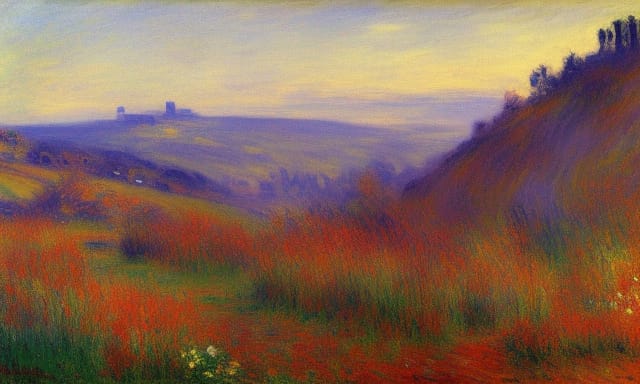
Impressionism was a major art movement of the late 19th century and it had a significant influence on the development of art in the 20th century. Some famous Impressionist artists include Claude Monet, Edgar Degas, Pierre-Auguste Renoir, Camille Pissarro, and Berthe Morisot, their works are considered as some of the most popular and well-known paintings in the world, and they continue to inspire artists today.
Impressionism is not only limited to paintings, it also influenced music, literature and other art forms, it is considered as a revolution in the way art is created
What is kinetic pointillism?
Kinetic pointillism is a term that is used to describe a specific style of art that combines elements of kinetic art and pointillism. Kinetic art is an art form that focuses on movement, often achieved through the use of mechanical or electronic devices, such as gears, motors, or computer-controlled systems. Pointillism, on the other hand, is a painting technique that involves the use of small, individual dots of color to create an image.
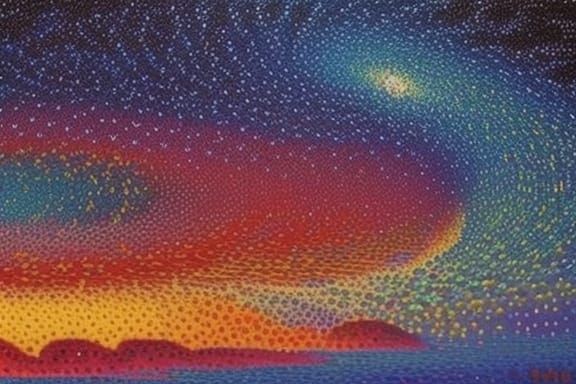
Kinetic pointillism, as the name implies, combines these two art forms by creating artworks that feature small, individual dots of color that are in motion. This can be achieved through the use of mechanical or electronic devices, such as gears, motors, or computer-controlled systems, to move the individual dots, or by using digital technology and programing. The result is an art form that creates the illusion of movement, and the viewer experiences an almost hypnotic effect by the continuous movement and color change.
The style is considered as a niche and experimental, it is not widely known and adopted yet, as it requires a specific set of technical skills and knowledge. Kinetic pointillism artworks are usually interactive, as the viewer can control or manipulate the movement. There are only a few kinetic pointillism artist who work in this style and they often work in digital mediums or interactive installations and exhibits
What is lyrical abstraction?
Lyrical abstraction is an art movement that emerged in the 1940s and 1950s, characterized by a focus on emotion and intuition, and the use of free-flowing and spontaneous forms to create a sense of movement and energy. Lyrical abstractionists sought to create art that expressed their innermost feelings and emotions, rather than depicting the external world in a realistic way.
The style of Lyrical Abstraction is characterized by a departure from the geometric abstraction and the hard-edge painting that had been popularized during the 1930s and 1940s. Artists instead focused on creating artworks that were fluid and expressive, often using gestural brushstrokes, vibrant colors, and bold forms to convey a sense of movement and energy.
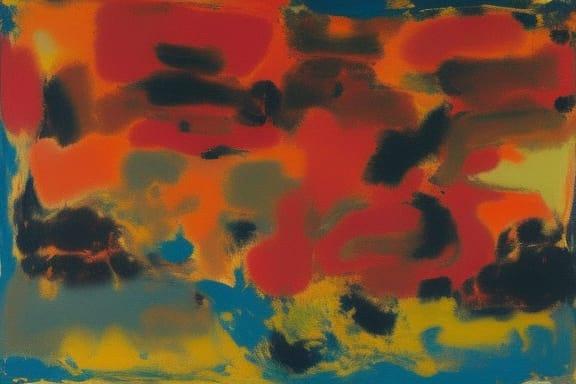
Lyrical Abstraction was popularized by a group of artists in the 1940s and 1950s, such as Willem de Kooning, Jackson Pollock, Mark Rothko, Helen Frankenthaler and many others. They sought to create a new form of abstraction that was more emotional, intuitive and spontaneous. They believed that the traditional forms of abstraction were too intellectual and detached, and they wanted to create something more personal and immediate.
Lyrical Abstraction was an important art movement of the post-war period and had a significant impact on the development of contemporary art. It still continues to influence artists today, and its emphasis on emotion and intuition remains a significant aspect of contemporary art practice.
What is mannerism?
Mannerism is an art movement that emerged in the late 16th century, characterized by a style that is characterized by a highly stylized and artificial approach to art, often characterized by elongated figures and twisted poses, as well as a highly decorative and ornate use of line, color, and form.
Mannerism was a reaction to the balance and harmony of the High Renaissance art and sought to break away from the idealized realism of the earlier style by introducing more complexity, dissonance, and artifice into the work. The style often featured elongated figures, twisted poses, and dramatic contrasts of light and shadow, which were intended to create a sense of tension and movement.
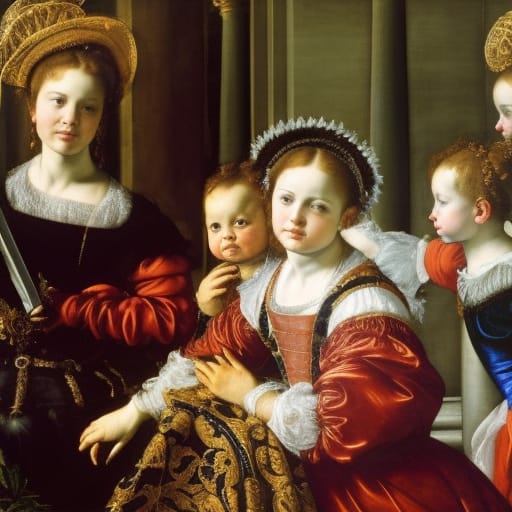
Mannerism was particularly popular in Italy and it spread across Europe and it was particularly popular in the courts of Northern Europe and Spain, where it was used to demonstrate wealth, prestige, and power. Many famous Mannerist artists, such as Tintoretto, Bronzino, and Parmigianino, produced a wide range of works in this style, including paintings, frescoes, and sculptures.
The style of Mannerism is highly stylized, decorative and ornate, it’s often associated with the excess and artificiality of the courts of the time, but it also is considered as an important link between the Renaissance and Baroque art. Mannerism was a significant art movement of the late 16th century and had a lasting impact on the development of Western art.
What is matte painting?
A matte painting is a technique used in the film and video game industry to create the illusion of a set or location that is not physically present during filming or in the game. It is a digital or traditional painting of a landscape, set, or location that is composited into live-action footage or video game graphics to create the illusion that the footage was shot on location. Matte paintings are used to create backgrounds and environments that are too expensive or impossible to film in live-action.
What is maximalism?
Maximalism is a term used to describe a style or approach that emphasizes excess and extravagance, often characterized by the use of bold and striking visuals, patterns, and colors. In the art world, maximalism is often associated with the use of multiple materials, forms, and textures in a single piece of art, as well as a layering of different elements and motifs. In literature, maximalism may refer to a style characterized by a profuse and ornate prose, extended metaphors, and a focus on the intricate details of characters, settings, and events.
In general, maximalism can also be applied to other fields as well, to describe a approach or attitude that emphasizes the quantity, complexity or extensiveness.
What is minimalism?
Minimalism is a style or approach characterized by simplicity and the use of minimal elements. It is often associated with a focus on functionality and the use of basic shapes, forms, and colors.
In the art world, minimalism is characterized by the use of simple geometric shapes, plain surfaces and a limited color palette. The style is often associated with the work of artists like Donald Judd, Dan Flavin, and Frank Stella.
In literature, minimalism is characterized by a simple writing style, short sentences, and a focus on the essentials.
Minimalism can also be applied to other fields such as architecture, product design, and music, where it is associated with a focus on simplicity and functionality. It is commonly associated with the style of decluttering, reducing possessions and living with less.
What is modern art?
Modern art refers to the artistic movements and styles that developed from the late 19th century to the mid-20th century. It encompasses a wide range of movements, styles, and mediums, including impressionism, post-impressionism, fauvism, cubism, futurism, and abstract expressionism, among many others.
The artists associated with modern art rejected traditional art forms and techniques, and instead experimented with new styles, techniques, and mediums to express their ideas and emotions. They sought to capture the rapidly changing world around them and to break free from the constraints of traditional art.
One of the hallmarks of modern art is the emphasis on self-expression and individualism, as opposed to the traditional focus on replication of nature. Additionally, many modern artists sought to use new mediums such as photography, film and new materials to break boundaries of traditional art forms.
Modern art has had a profound impact on the art world, and continues to shape contemporary art and the way we perceive and interact with art today.
What is modern European ink painting?
Modern European ink painting is a term that refers to the use of traditional Chinese ink painting techniques and materials by European artists. This form of art emerged in the late 19th century and early 20th century, as artists began to explore and experiment with the use of traditional Chinese ink, brushwork, and composition in their own art.
Some notable figures in modern European ink painting include the German artist Käthe Kollwitz, who was deeply influenced by Chinese calligraphy and the German Expressionism movement, and the French artist Séraphine Louis, who was drawn to the simplicity and minimalism of Chinese ink painting.
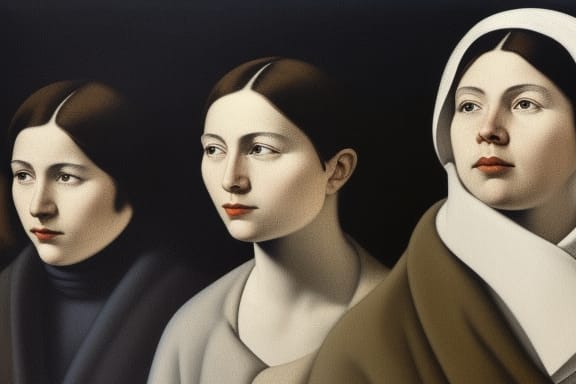
Many of these artists were fascinated with the abstract and expressive qualities of Chinese ink painting and sought to incorporate these elements into their own art. This approach is particularly evident in the works of artists who sought to capture the emotional and spiritual elements of Chinese art in their own way.
Modern European ink painting continues to be an important part of the art world, and it continues to be a source of inspiration for many contemporary European artists. It has contributed to the development of a new form of art which is the fusion of East and West.
What is naïve art?
Naive art, also known as primitive art or folk art, is a style of art characterized by a childlike simplicity and a lack of formal training in the artist. The artists often have a distinct personal style and may not conform to traditional art conventions. The term “naive” refers to the simplicity and innocence of the artist’s approach to the subject matter, rather than to the artist themselves. Some examples of naive art include the paintings of Henri Rousseau and Grandma Moses, as well as the crafts produced by traditional cultures such as African and Native American.
What is neo-primitivism?
Neo-primitivism is an art movement that emerged in the early 20th century that looked to the art and culture of so-called “primitive” societies for inspiration. Neo-primitivists rejected the academic art and the capitalist values of the modern world, instead celebrating the simplicity and spiritual qualities of the art of non-Western cultures. The artists associated with the movement sought to express spiritual or emotional states through the use of simple forms and bold colors, often drawing inspiration from the art of Africa, Oceania, and other non-Western cultures. Artists like Picasso and Matisse were influenced by this movement in their early works, that later developed to become cubism and fauvism. It’s considered as a stylistic tendency which appears on the art created by some of the avant-garde of the early 20th century, whose main objective was to break away from the dominant academicism of the time and to rescue from oblivion the art of cultures considered “primitive” or “archaic.”
What is photorealism?
Photorealism is a style of art that seeks to depict the subject as realistically as possible, using the same techniques as a photograph. Photorealist painters typically work from photographs, using them as a reference for composition and color. The aim is to create the illusion of a photograph in a painting, drawing or print. The technique often includes the use of airbrush and other tools to achieve a high degree of realism and accuracy in the finished piece.
The photorealism movement began in the late 1960s and gained popularity in the 1970s. Artists associated with the movement include Chuck Close, Richard Estes, and Audrey Flack, who were heavily inspired by the photographic images of the day and incorporated them into their artworks. Photorealism has been considered both as a form of hyperrealism and a form of pop art.
Photorealism works often depict common objects, such as cars, buildings, or people, and tend to be highly detailed and precise. The compositions are usually static and focus on the realistic representation of the subject matter.
What is pointillism?
Pointillism is a technique of painting in which small, distinct dots of color are applied in patterns to form an image. The technique was developed by the French Impressionist artist Georges Seurat in the late 19th century and is also known as “divisionism.”
The basic principle of Pointillism is that the colors used in the painting will blend together in the viewer’s eye when viewed from a distance, creating a harmonious whole. Instead of mixing pigments together on a palette, pointillist artists applied small dots of individual colors to the canvas, letting the eye and the brain of the viewer blend them together. By using this technique, Pointillists were able to create a wide range of colors and tones without the need for a traditional color palette.
Pointillism works are characterized by a high level of technical skill, as the artist must be able to control the size, shape, and placement of each dot in order to create a cohesive image. It’s considered a Post-Impressionist style, Pointillism paintings often have a sense of movement and optical vibration, due to the small dots that are used to make up the image. Some of well-known pointillists are Georges Seurat, Paul Signac, Camille Pissarro, Vincent van Gogh and others.
What is post-impressionism?
Post-Impressionism is a term used to describe a range of artistic styles that emerged in the late 19th century as a reaction to Impressionism. Like the Impressionists, post-impressionist artists sought to capture the changing moods and effects of light and color in the natural world, but they did so in ways that were more emotional, symbolic, and expressive. They were less interested in capturing a single moment in time and more focused on expressing their own feelings and ideas about the world.
Some of the key characteristics of post-impressionism include the use of bold, vibrant colors; the application of paint in thick, textured layers; and the use of strong, non-naturalistic lines and shapes to create a sense of movement and emotion. Artists associated with the post-impressionist movement include Vincent van Gogh, Paul Cezanne, Paul Gauguin, Georges Seurat, and Henri de Toulouse-Lautrec.
Post-Impressionism includes diverse styles, but they all share a rejection of the naturalistic approach of Impressionism and the search for a more expressive and personal art. Each artist developed their own individual style, but all of them focused on the subjective experience of the painter as a source for their art. They tend to express emotion and feelings more than the objective reality. Some of the tendencies within Post-Impressionism are Symbolism, Cloisonnism, Divisionism, Fauvism, and expressionism.
What is pre-raphaelitism?
Pre-Raphaelitism is a movement in art and literature that emerged in the mid-19th century in Britain. The Pre-Raphaelites rejected the academic art of the time, which they saw as being overly formal and artificial, and instead looked to the art of the late medieval period, before the time of Raphael, for inspiration. They sought to create a more naturalistic and emotional style of art that was true to nature and that would express deeper spiritual and moral truths.
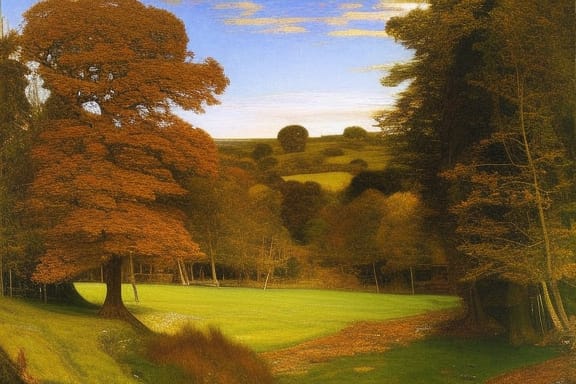
The Pre-Raphaelite Brotherhood, was a group of young artists, including William Holman Hunt, John Everett Millais, and Dante Gabriel Rossetti, who formed in 1848 in reaction to the Royal Academy and its influence. They sought to return to the use of detail, intense colors, complex compositions and emphasis on the spiritual and moral content of the art. They often painted in a very detailed, almost photographic style, and used a wide range of bright, pure colors. They also often drew inspiration from literature, particularly from medieval poetry and romantic literature, and many of their paintings depict scenes from these works.
Pre-Raphaelitism had a significant impact on British art and culture in the 19th century and its influence can be seen in the work of many later artists. Its influence can be seen in various forms of art like illustration, decorative arts, graphic design and other artistic movements like Arts and Crafts.
What is precisionism?
Precisionism is an art movement that emerged in the United States in the 1910s and 1920s, and it is often considered as the first American avant-garde art movement. The style is characterized by precise, geometric shapes and a highly stylized and almost machine-like appearance. Precisionist artists sought to capture the dynamism and power of the modern industrial world, particularly in the urban landscape.
Precisionist painters and architects sought to create a new American aesthetic, emphasizing the precise and precise geometry, abstraction, and the clean lines of the new industrial structures. The movement was influenced by Cubism, Futurism and other European avant-garde movements of the time, as well as by the geometric forms and precision of American industrial design.
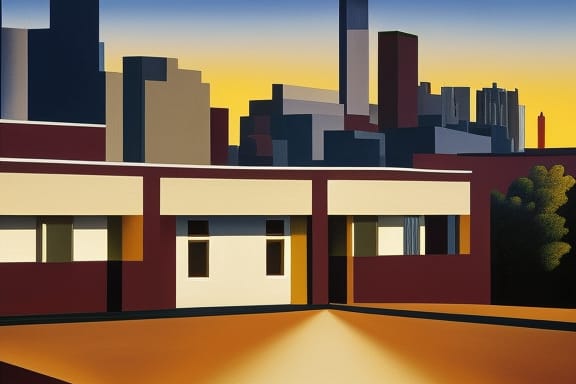
Some of the key figures in the precisionist movement include Charles Demuth, Ralston Crawford, Charles Sheeler and Georgia O’Keeffe. Their works often depict industrial landscapes, urban scenes, and architectural forms, such as skyscrapers, bridges, and machinery, and they are known for their clean, precise lines and geometric shapes. They were also interested in representing movement, often with the use of diagonal lines and overlapping shapes to create a sense of dynamism.
Precisionism as a term coined by American Art historian James Mooney in the 1920s and it’s considered to be a stylistic tendency rather than a formal art movement, but it’s part of American modernism and it reflects the optimism and confidence in technology of the era.
What is primitivism?
Primitivism is an art movement that emerged in the late 19th and early 20th centuries, characterized by the use of forms and motifs from so-called “primitive” cultures, such as those of Africa, Oceania, and pre-Columbian America. The term “primitivism” refers to the belief that these cultures possessed a kind of spiritual or emotional purity that had been lost in the modern world, and the artists associated with the movement sought to tap into this perceived purity through the use of primitive forms and motifs.
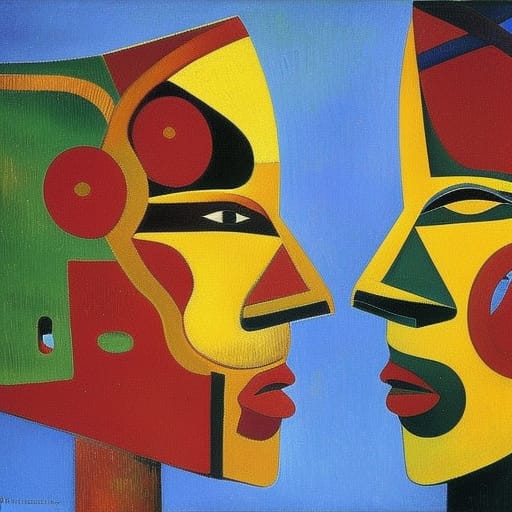
Artists such as Paul Gauguin, Pablo Picasso and others, were heavily influenced by primitivism, and their works often depict figures and motifs from non-Western cultures, such as African masks and statues, in a stylized and simplified manner. These artists were fascinated by the raw power and expressive qualities of “primitive” art and sought to incorporate these qualities into their own work.
Primitivism has been heavily debated among art historians, some of them sees it as a form of cultural appropriation, while others argue that artists were genuinely drawn to the expressive power and simplicity of “primitive” art, and that their use of these forms was an attempt to tap into something deeper and more universal. Nevertheless, the movement has influenced many other movements like Fauvism, Expressionism, and Surrealism and has contributed to the development of the 20th century art.
What is psychedelic art?
Psychedelic art is a style of art that emerged in the 1960s in response to the counterculture of the time and is characterized by bold, bright colors, unusual and surreal imagery, and abstract shapes and patterns. The art is often intended to evoke a sense of the transcendent or mystical and is intended to be viewed in a state of altered consciousness, usually achieved through the use of psychedelic drugs such as LSD.
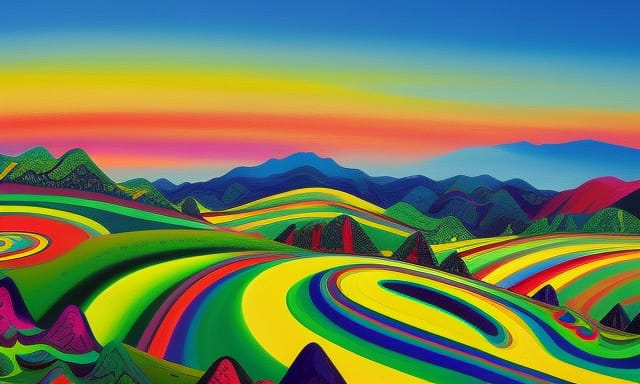
Psychedelic art can take many forms, including painting, sculpture, graphic design, and even architecture. It is often used to illustrate album covers, posters, and other forms of media associated with the psychedelic subculture. These works of art often depict landscapes, portraits and abstract compositions, with bold, bright colors, swirling patterns, and other visually stimulating elements, to create the sensation of motion and change, often distorting and playing with the perception of reality. The psychedelic art also often reflects the ideas of the hippie and counterculture movement of the time, such as the use of psychedelic drugs, the anti-war and anti-establishment sentiment, and the exploration of spirituality and the nature of consciousness.
Some of the well-known psychedelic artists include Peter Max, Rick Griffin, and Victor Moscoso. Psychedelic art had a significant impact on the cultural landscape of the 60s and it’s still considered as a style that is able to express the feelings and ideals of a whole generation.
What is qajar art?
Qajar art is the art and architecture produced during the Qajar dynasty in Iran, which lasted from 1785 to 1925. The Qajar period saw a flourishing of various forms of art and architecture, including painting, pottery, metalwork, textiles, and architecture.
Qajar art is characterized by a combination of traditional Persian motifs and styles with elements borrowed from European and other Western styles. Qajar painters often used a bright and highly saturated palette of colors, and they were known for their detailed and realistic depictions of everyday life, landscapes, and historical events. They also created many portraits of Qajar kings and princes, as well as other members of the royal court, and these portraits are considered some of the most important works of art from this period.
In architecture, Qajar buildings were influenced by traditional Persian styles, as well as by Western styles such as Baroque and Rococo. They featured elaborate tilework, stucco decorations, and ornate wooden balconies and arches. Some of the most famous examples of Qajar architecture include the Golestan Palace and the Niavaran Palace in Tehran.
Qajar art also saw the development of a wide range of decorative arts such as metalworking, ceramics and textiles. These decorative arts often used traditional Islamic motifs, but also incorporated elements of European and Asian styles. The Qajar period is considered as an important time for the Persian art, that created a synthesis between traditional Persian art and the new influences of the West.
What is renaissance painting?
Renaissance painting refers to the style of painting that developed during the Renaissance period in Europe, which lasted from the 14th to the 16th centuries. The Renaissance was a cultural movement that began in Italy and spread throughout Europe, marked by a renewed interest in classical culture and the arts.
Renaissance painting is characterized by a renewed interest in realism, naturalism, and humanism. Artists of the Renaissance sought to depict the natural world as accurately as possible and to capture the beauty and individuality of the human form. They also aimed to convey a sense of movement and depth in their works, using techniques such as linear perspective, foreshortening, and sfumato (a technique of blending colors to create a soft, hazy effect).
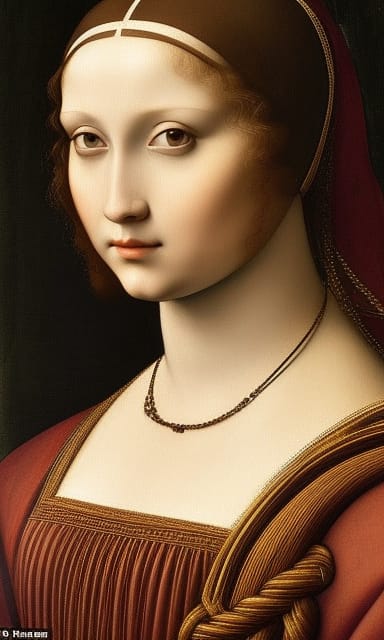
Some of the most famous Renaissance painters include Leonardo da Vinci, Michelangelo, Raphael, Sandro Botticelli, Titian, and many others, who created some of the most iconic and well-known works of art in the Western tradition, such as the Mona Lisa, The Last Supper, The Sistine Chapel ceiling, the Birth of Venus and many others.
Renaissance painting had a profound impact on the development of Western art, and it marks a transition from the medieval to the modern era. Many of the techniques and styles developed during the Renaissance are still used and studied by contemporary artists and are considered as the foundation of the western painting tradition.
What is retrofuturism?
Retrofuturism is an art and design movement that combines elements of nostalgia for past styles with a vision of a future that never came to be. It is characterized by a nostalgic or ironic view of technology and design from the past, often with a science fiction or fantasy aesthetic.
Retrofuturism often incorporates elements of design and technology from the 1950s and 1960s, such as the designs of cars, buildings, and household appliances from that era. But instead of recreating these styles as they were, artists and designers often reimagine them with elements of science fiction, fantasy, and other futuristic motifs.
The art and design of retrofuturism often depict a sort of imagined past future, a vision of a world that might have been, if the technology and social changes of the era had developed differently, the outcome would have been a different. This can be seen in films like Blade Runner, or video games like Bioshock, which have a retrofuturistic aesthetic that’s both nostalgic and speculative.
Retrofuturism is a playful and imaginative style, which allows the creators to look back to the past with a sense of nostalgia but also with a sense of irony, to imagine an alternative vision of the future. The movement has also influenced fashion, graphic design, architecture, and popular culture in general, it’s still going strong, and it’s considered as a popular movement among designers and visual artists today.

Some of the most famous painters who have been associated with the retrofuturism movement include:
- Syd Mead: He is considered as one of the most influential designers in the field of Retrofuturism, is known for his work in science fiction, particularly for his concept art in the Blade Runner and Tron movies. He is a painter, designer, and illustrator and his work is characterized by a high degree of precision, realism, and attention to detail.
- Chris Foss: He is a British science fiction artist and illustrator, known for his science fiction book covers, and he is considered one of the most important science fiction illustrators of the 1970s and 1980s, his work often features advanced technology, spaceships and otherworldly landscapes, in a detailed and realistic style that gives his paintings a sense of authenticity.
- Jean “Moebius” Giraud : He was a French artist, cartoonist, and writer, widely considered one of the most influential comic book creators of the 20th century. His work had a strong influence on science fiction illustration and he has been associated with the retro-futuristic aesthetic, which is present in many of his works, such as his famous comic series “The Incal”
- Michael Whelan: He is a painter and illustrator, who specializes in science fiction and fantasy artwork, his works often feature detailed, realistic landscapes and futuristic technology, that are influenced by the Retrofuturism aesthetic, He has illustrated many book covers, magazines, and album covers, winning numerous awards for his work.
- H.R Giger: He was a Swiss painter, sculptor, and set designer, whose work was heavily influenced by science fiction and horror and often had a retro-futuristic aesthetic. He is probably best known for his design work on the Alien film franchise.
This is just a small selection of some of the most notable retrofuturism painters, there are many others as well, and many contemporary artists who also incorporate elements of retrofuturism into their work.
What is romanticism?
Romanticism was a cultural and intellectual movement that emerged in Europe in the late 18th century and lasted until the mid-19th century. The movement was characterized by an emphasis on emotion, imagination, and individualism. It was a reaction to the Enlightenment and the Industrial Revolution and rejected the rationality and order of the earlier era in favor of a more emotional and individualistic approach to art and life.
In art and literature, romanticism is characterized by a focus on intense emotions, such as love, awe, and terror, as well as a fascination with the natural world and the past, especially the Middle Ages and the Renaissance. Romantics often sought to convey a sense of the sublime, or the awe-inspiring and mysterious, in their work. They also idealized the common people and the nobility of the past, and rejected the contemporary urbanization and industrialization.
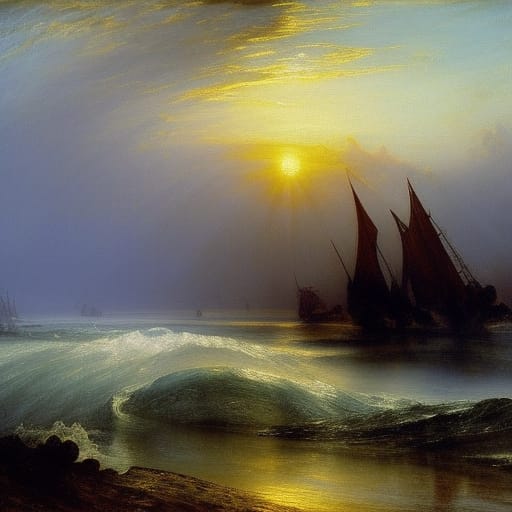
“The most beautiful romanticism painting of a seascape by Caspar David Friedrich, John Constable, J.M.W. Turner”
In painting and visual arts, romanticism is characterized by a use of bold colors and dramatic lighting, and a preference for the heroic, the melancholic and the sublime, as well as a romanticized portrayal of nature and the past. Artists such as Caspar David Friedrich, John Constable, J.M.W. Turner, are some examples of painters who are considered part of the romanticism movement.
In literature, Romanticism is associated with poets like Samuel Taylor Coleridge, William Wordsworth, John Keats, and Percy Bysshe Shelley, who wrote about the natural world and personal experiences in an emotional and spontaneous way. The movement had a profound impact on the arts and culture of the time and continues to influence contemporary literature, art, and music.
What is shin hanga?
Shin hanga (新版画) is a term used to describe a movement of Japanese printmaking that emerged in the early 20th century. The term literally means “new prints” and refers to a style of woodblock prints that combined traditional Japanese printmaking techniques with Western-style compositions and printing methods. Artists associated with the shin hanga movement included such figures as Hasui Kawase, Shinsui Ito, and Kiyoshi Saito.
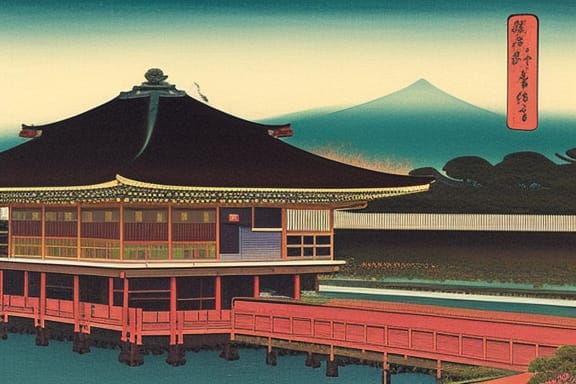
“The most beautiful Shin hanga painting about sukula plum by Hasui Kawase, Shinsui Ito, and Kiyoshi Saito.”
What is splash art?
Splash art is a type of digital illustration that is primarily used in the video game industry as concept art for characters and environments in games, game covers, key art for promotion and concept art for Cinematic intro and cutscenes. Splash art usually is a single illustration of a character or scene, where the focus is on creating a dramatic and impactful image that captures the essence of the game or character. It is often large, detailed, and done in vibrant colors, with the composition and lighting used to create a sense of movement, action, and excitement. They are also used in other fields like comic books and trading card games.

“a most beautiful splash art painting of a heroic character by J. C. Park,Wei Wang,Hyung-tae Kim,Kekai Kotaki,Craig Mullins,Feng Zhu”
Many well-known and talented digital painters have been associated with splash art in the video game and other industries. Some examples include:
- J. C. Park, a South Korean painter and concept artist who is known for his detailed and vibrant illustrations in the video game industry.
- Wei Wang, a Chinese painter and illustrator who has worked as a concept artist for video games and animation.
- Hyung-tae Kim, a South Korean painter and concept artist who is known for his fantasy-themed illustrations and character designs.
- Kekai Kotaki, a Hawaiian artist who has worked in the video game industry as a concept artist for games like Guild Wars 2 and Diablo 3
- Craig Mullins, an American digital artist, and illustrator known for his work in the video game industry and on movies like The Matrix and The Hunger Games.
- Feng Zhu, a Chinese-born concept artist, and industrial designer, has worked on game development, film, and architecture
These are just a few examples of the many talented artists who have worked in the splash art style.
What is storybook illustration?
Storybook illustration is the art of illustrating children’s picture books and other types of stories. It includes illustrations, cover designs, and the overall visual design of the book. This can be done in a variety of mediums, such as traditional painting, drawing, and printmaking, as well as digital art. Storybook illustration is characterized by its ability to enhance and complement the story, provide visual cues, establish mood and style and help children understand the text.
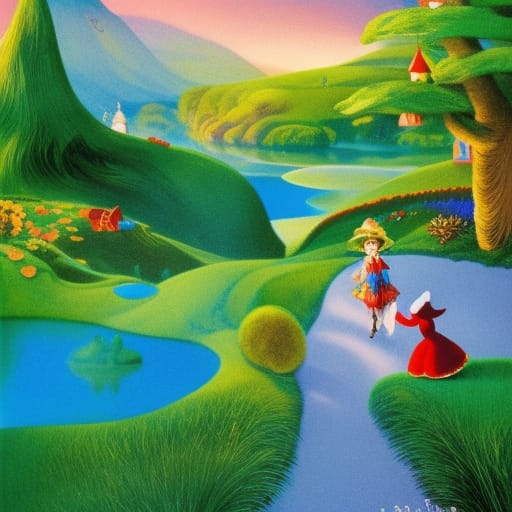
“the most beautiful storybook illustration about a fairy land story book by Eric Carle, Dr. Seuss, Maurice Sendak”
Storybook illustrators often work closely with authors and publishers to develop the visual elements of the book, and are responsible for creating illustrations that are appropriate for the target audience and that complement the story being told. They are also expected to be able to tell a story through the illustration, to complement the written story and convey emotions. Famous storybook illustrators includes names like Eric Carle, Dr. Seuss, Maurice Sendak, and many others.
What is street art?
Street art refers to any form of visual art that is created on or in public spaces, such as buildings, sidewalks, bridges, and other structures, without the permission of the property owner. Street art is a type of self-expression, a form of communication and artistic expression that emerged in the 20th century and it is often used as a form of protest or as a commentary on social issues. Street art can include a wide range of styles and mediums, such as graffiti, murals, stickers, installations, and more.
Street art is usually created by anonymous or pseudonymous artists who go by street names or tags, rather than their real names, and it is often associated with the urban subcultures of hip-hop and punk. Street art is known for its bold, vibrant and colorful appearance and often creative manipulation of typography, lettering and branding.
It is important to note that street art is often considered as vandalism, and it’s legality can vary depending on the country or municipality. Even though it is illegal, some cities have begun to embrace it as a form of public art and have designated areas where street artists can create and display their work.
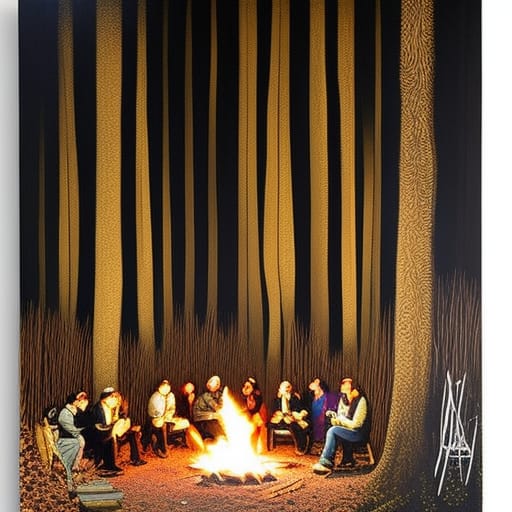
“the most beautiful street art painting about a meeting Campfire in a forest by Banksy,Shepard Fairey,RETNA,Jean-Michel Basquiat,JR,Swoon”
There are many talented and well-known street artists, here are few examples:
- Banksy, anonymous England-based street artist, political activist, and film director. He is known for his politically charged and often controversial street art that features striking imagery, satire, and dark humor.
- Shepard Fairey, an American contemporary street artist, graphic designer, and illustrator who is best known for his Andre the Giant Has a Posse and Obama “Hope” campaign posters.
- RETNA (Marquis Lewis), an American street artist known for his large-scale, calligraphic text-based works that draw from various typographic and cultural sources.
- Jean-Michel Basquiat, an American artist who rose to fame as part of the graffiti art movement in the 1970s before transitioning to Neo-expressionism art in the 1980s.
- JR, a French artist and photographer known for large-scale street art installations and portrait projects, especially his projects which use the urban space.
- Swoon (Caledonia Dance Curry), American street artist known for her detailed life-size wheat-pasting of paper cut-outs of human figures and faces.
These are just a few examples of the many talented street artists who have made a significant impact on the street art scene.
What is surrealism?
Surrealism is an art movement that began in the 1920s, characterized by the use of fantastical and dream-like imagery, as well as the exploration of the subconscious mind. The term “surrealism” is a combination of the words “sur” (meaning “above” or “beyond”) and “réalisme” (meaning “realism”). The movement sought to challenge the rational and logical approach to art and to tap into the power of the unconscious mind to create art that was thought-provoking and emotionally evocative.
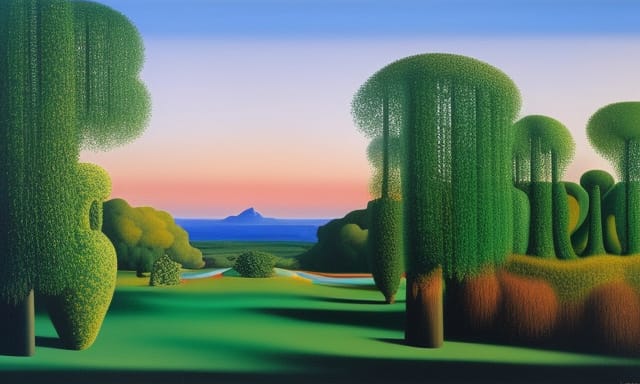
“A most beautiful surrealism forest landscape painting by Salvador Dalí, René Magritte, Max Ernst, and Joan Miró”
The artworks created during the Surrealist movement often feature unexpected combinations of imagery and objects, and they are meant to provoke an emotional response in the viewer. The artists use symbolism and metaphor to create a sense of unease or disorientation. Surrealism uses a wide range of mediums from painting, sculpture, graphic art, to poetry, film and photography.
In literature, Surrealism is often associated with the idea of automatism, which is the technique of expressing oneself in writing or art without conscious control, thus allowing the unconscious mind to reveal itself.
Some of the most well-known artists associated with Surrealism include Salvador Dalí, René Magritte, Max Ernst, and Joan Miró. The works of these artists, and many others associated with the movement, continue to inspire and influence contemporary art and popular culture today.
What is synthetism?
Synthetism is an art movement that emerged in the late 19th century, particularly in France. Synthetism is an art style that emphasizes the use of simplified forms, bright colors, and flat areas of color. The movement was a reaction against the naturalism of the time and a reaction to the Impressionism, the goal of the movement was to simplify the subject matter and to create a symbolic and emotional impact in the viewer.
The name “synthetism” comes from the word “synthesis” and refers to the artists’ goal of synthesizing elements from different sources to create new, unified works of art. The artists of this movement sought to express emotions and ideas through a stylized, simplified visual language that combined symbolism, abstraction, and flat, decorative forms.
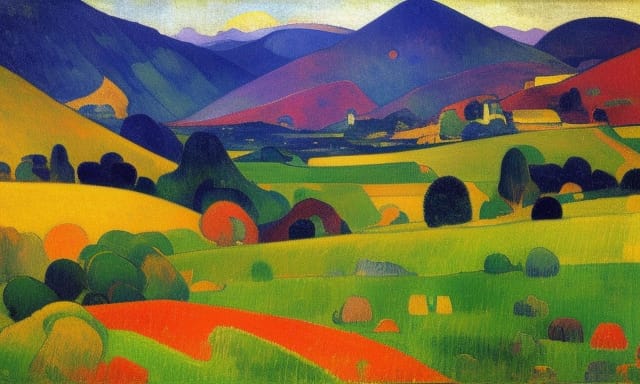
“A most beautiful synthetism mountainous landscape painting by Paul Gauguin, Émile Bernard, and Paul Sérusier”
The artists of the Synthetist movement were influenced by the decorative art of Japan and other non-Western cultures, and by the work of the Post-Impressionist artist Paul Cézanne. Some notable artists associated with Synthetism include Paul Gauguin, Émile Bernard, and Paul Sérusier. These artist’s works can be seen as a link between Impressionism and later movements such as Fauvism and Expressionism. The movement was relatively short-lived and by the early 20th century, it had largely been subsumed by other movements such as Fauvism and Cubism, but it influenced many other artists and movements.
What is Ukiyo-e?
Ukiyo-e (浮世絵) is a genre of Japanese art that emerged in the 17th century and reached its peak of popularity in the 19th century. The term “ukiyo-e” can be translated as “pictures of the floating world”, and it typically refers to woodblock prints that depict various aspects of life in Japan during that time period. Ukiyo-e artists typically produced prints of popular actors, courtesans, sumo wrestlers, landscapes, flora and fauna, and kabuki theater scenes, as well as scenes from everyday life.
The process of creating ukiyo-e prints involved several stages: first, the artist would create a detailed sketch or painting, which would then be transferred to a wooden block. The block would then be carved, with each color printed separately, resulting in a final print that could be sold to the general public.
Ukiyo-e prints were popular among the merchant class, and were widely collected, hung on the wall or stored in albums. They were also collected and admired by the upper classes, but due to the large quantity of reproductions and its relatively low prices, ukiyo-e prints were considered a more affordable way for the common people to own a piece of art.
Ukiyo-e’s influence extends far beyond Japan, and many Western artists were influenced by this art form, such as Vincent van Gogh and Claude Monet. Ukiyo-e prints are still highly valued today and are considered an important part of Japan’s cultural heritage.
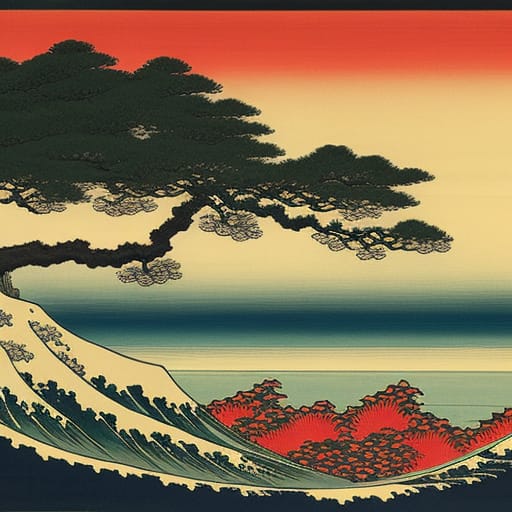
“The most beautiful ukiyo-e type painting by Hokusai,Utagawa Hiroshige,Sharaku,Torii Kiyonaga,Utagawa Kuniyoshi,Katsushika Hokusai,Utagawa Toyokuni”
Ukiyo-e is an art form that has produced many notable artists. Here are a few well-known ukiyo-e artists and printmakers of that period:
- Hokusai: He was one of the most famous ukiyo-e artists of the Edo period, and his most famous work is “The Great Wave off Kanagawa”
- Utagawa Hiroshige: He was known for his landscapes, especially views of the Tokyo-Edo (present-day Tokyo) and the Tokaido Road
- Sharaku: He was a mysterious artist who active in the late 18th century, famous for his portraits of Kabuki actors.
- Torii Kiyonaga: He was a master of bijinga, or pictures of beautiful women, and his works are considered some of the finest examples of the genre.
- Utagawa Kuniyoshi: He is known for his dynamic compositions, his strong sense of humor, and his emphasis on individuality.
- Katsushika Hokusai: He was a very versatile artist, and during his lifetime, he produced a variety of works from landscapes, mountain ranges, and seascapes, to portraits and illustrations of historical figures.
- Utagawa Toyokuni: He was a well-known ukiyo-e artist and was famous for his portraits of actors.
These are a few of the well-known ukiyo-e artists of that period, but there were many other artists that also contributed to the development of this art form.
What is underground comix?
Underground comix are a type of comics that were created in the 1960s and 1970s as an alternative to mainstream comics. They were produced independently, outside of the mainstream comics industry, and typically dealt with more controversial or adult themes than traditional comics.
Underground comix generally had a countercultural, anti-establishment tone, and dealt with topics such as sex, drugs, and politics. They often depicted strong sexual content, graphic violence, and satirized social and political issues. Creators were not constrained by the Comics Code Authority which was a self-regulatory organization that established guidelines for the content of comics in North America.
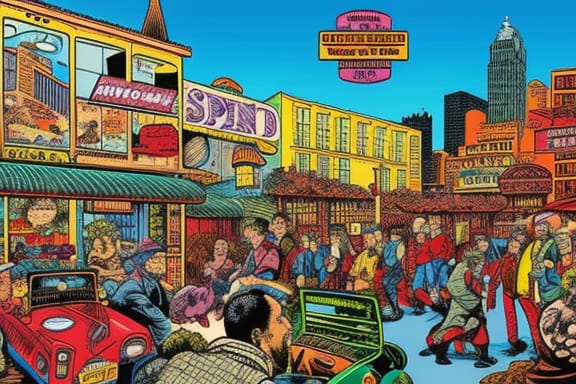
“a most beautiful underground comix painting by Robert Crumb,Kim Deitch, Bill Griffith, and Spain Rodriguez.”
The underground comix movement was started by artists such as Robert Crumb, who published the first underground comix, Zap Comix, in 1968. Other notable underground comix creators include Kim Deitch, Bill Griffith, and Spain Rodriguez. They were sold primarily in head shops, record stores, and through mail order, they reached a small but devoted audience.
The underground comix movement was a significant part of the counterculture of the 1960s and 1970s, and it had a lasting impact on the comics industry and popular culture, influencing later alternative comics, graphic novels, and mainstream comics.
What is vorticism?
Vorticism was a short-lived art movement that emerged in England in the early 20th century. It was primarily associated with visual art and poetry, but the movement also had a strong influence on architecture and industrial design. Vorticism was a form of abstract art that sought to capture the energy and movement of the modern world, and it was closely associated with the Italian Futurist movement.
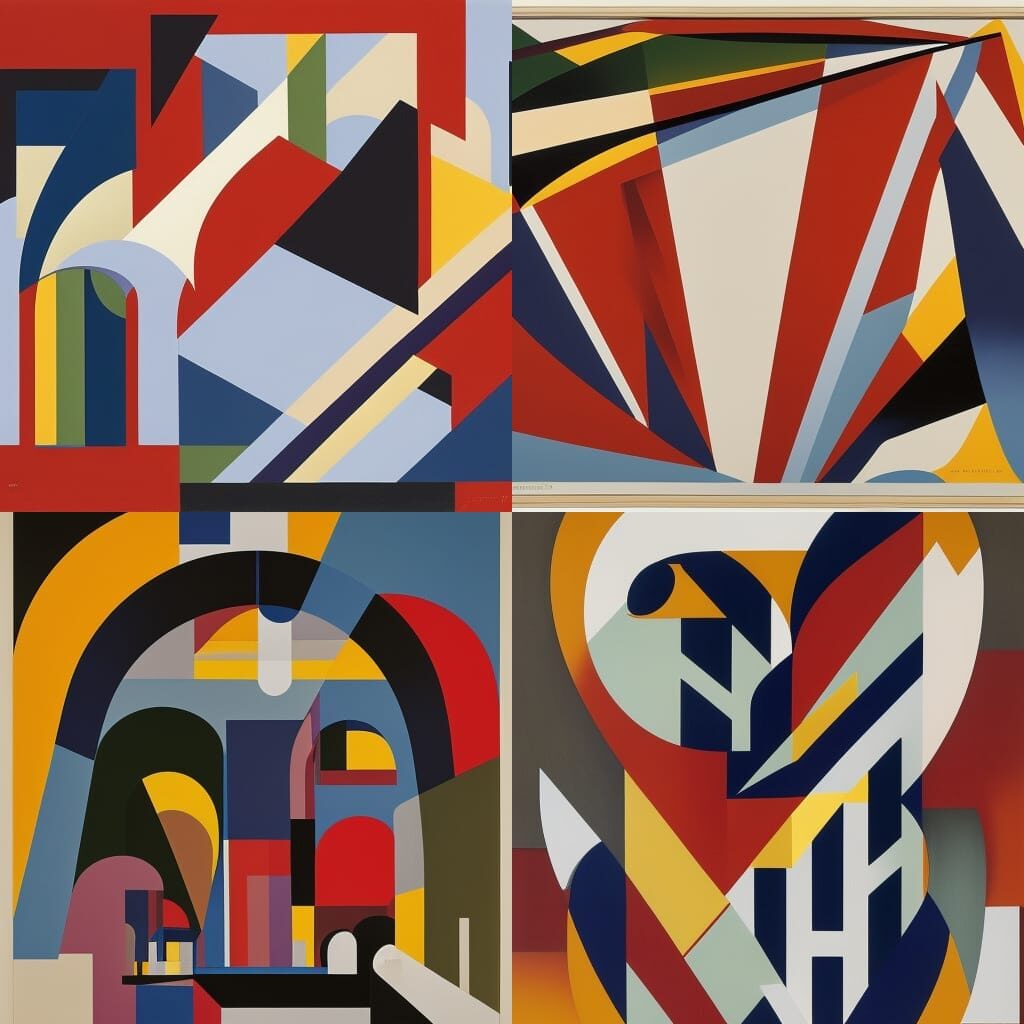
“The most beautiful Vorticism painting by Edward Wadsworth,Lewis, Ezra Pound,Wyndham Lewis”
The name “Vorticism” comes from the word “vortex,” which refers to a whirlpool or spiral of energy. The movement was led by Wyndham Lewis, who founded the magazine “BLAST” as a platform for the movement’s ideas and artworks. Vorticism was active from 1914 to 1915, and its leading figures included Lewis, Ezra Pound, and the artist and designer Edward Wadsworth.
